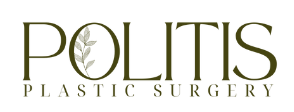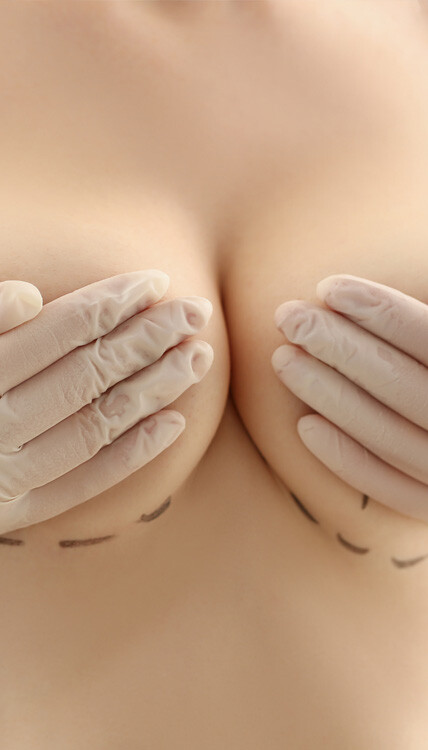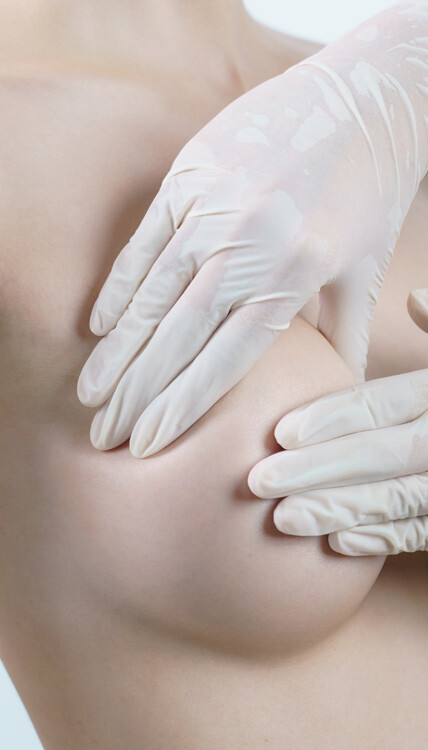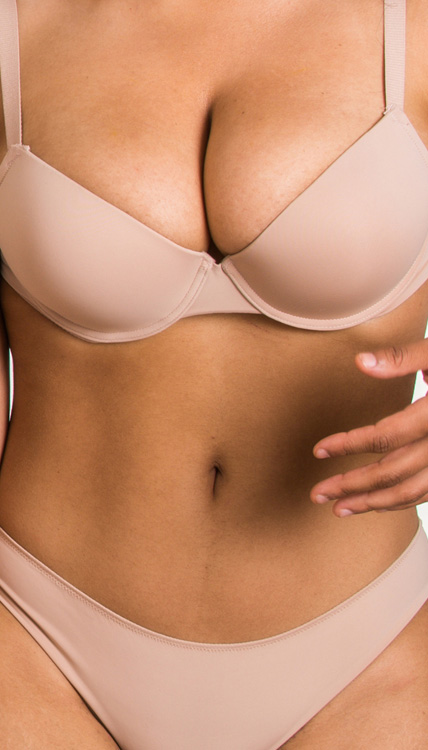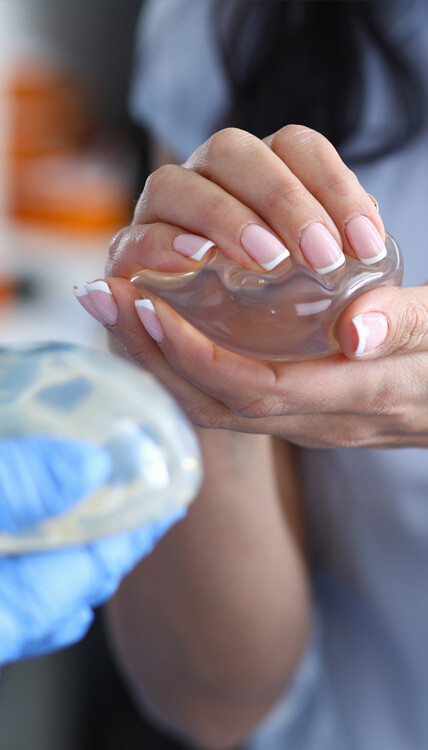This patient is 5’7″ and 166lbs.
She is a massive weight loss patient and had a mastopexy when she was younger.
After having 5 children, she wanted to correct the deflation in her breast and restore upper pole fullness.
She underwent bilateral breast augmentation with Sientra smooth round HSC+ silicone implants, 355cc, moderate profile.
This was a quick turn-over, 24-hour recovery breast augmentation procedure.
A massive weight loss patient who had a mastopexy or breast lift in the past likely has week tissues and ligaments that require internal support or scaffold for stable and optimal long-term results.
I had Galaflex placed to support her lower breast pole, so the implants do not bottom out.
Each patient is evaluated whether there is a need for the Galaflex “internal bra”.
Post-op photo is 5 days after.
[Tap to view in full on IGTV!]
Are you a candidate for this procedure?
Your best bet is to come in for a consultation to determine whether you are an ideal candidate, but typically, the ideal candidate is relatively healthy and maintains a healthy weight. If you are a candidate for traditional breast augmentation, you are likely a candidate for this procedure too.
For more info on our 24-hour breast augmentation procedure, check the link in our bio.
Do breast implants make you float?
Do breast implants make you float? Will it save you from drowning?
Those are some questions that a few may have wondered about breast implants at some point.
Here’s the thing, breast implants are NOT a floatation device. They will not make you buoyant, nor are they a suitable alternative for a life vest.
“Breast implants are different from the weight of the natural breast, but not by much. While fatty tissue weighs slightly less than water, saline will, as mentioned, weighs roughly the same, and silicone, slightly more. “
“The differences between the natural tissue and a breast implant are minor, and, to the untrained eye, virtually undetectable.”
While breast implants are naturally buoyant (as seen in the video), “when placed in the body, however, the buoyancy of breast implants demonstrated by benchtop testing becomes irrelevant. Post-surgery breasts are no more likely to drown you than they are to save you from drowning.”
So, to answer the question above, no, breast implants will NOT make you float, and it will NOT save you from drowning.
Now, if you know someone who says they want to get large implants to have a built-in life-jacket, you can conclusively tell them to take some swimming lessons instead. 😅
What to consider before you get a breast augmentation
Considering breast augmentation?
Whether your reasons are for the enhancement of your appearance, correction of uneven breasts, or following a mastectomy procedure, there are several things you have to keep in mind.
When considering breast augmentation, it is important to speak with a plastic surgeon who will help you decide whether the procedure is right for you. At Politis Plastic Surgery, we will conduct a physical exam, get your medical history, listen to your concerns, consider your aesthetic goals, and offer options for how to proceed. We only recommend this surgical procedure to patients in good health who have realistic expectations. This is why the consultation is critical.
While your surgeon may use implants, fat transfer, or both to augment your breasts, the decision primarily depends on your existing breast tissue, body mass, and frame, as well as your desired body shape. The surgeon will create a personalized plan and provide you with pre-operative instructions to ensure the experience is as easy, safe, and comfortable as possible.
There’s more info on breast augmentation in our website. You can check the link in our bio.
Here is a sneak peek of our recent breast augmentation patient. Will share a full before & after soon, along with the behind-the-scenes of the procedure! Stay tuned!
What happens when implants too large for your chest/thorax are placed?
What happens when implants too large for your chest/thorax are placed?
Implant displacement, stretched-out thin breast tissue, and asymmetry.
This can only be fixed with revision, implant exchange, implant place change, and tissue scaffold for support.
Patients, do your homework. Implants need to be sized through tissue-based planning techniques by a board-certified plastic surgeon.
The 14-step plan is then initiated in OR to prevent contamination of implants leading to capsular contracture. Otherwise, tissue distortion and collapse as well as device malposition and capsular contracture are guaranteed down the road. This ultimately leads to more surgeries and low patient satisfaction.
Interlocking Cogwheel Suture for Mastopexy
The Interlocking Gore-Tex periareolar suture technique is used for periareolar closure to avoid postoperative widening of the nipple-areola complex.
The GORE-TEX® Suture is a microporous, monofilament suture of flexible biomaterial for excellent handling, reduced hole-leakage, and minimal irritation in soft tissue approximation.
This permanent suture helps in stabilizing the nipple-areolar complex over time to prevent widening or stretch deformity.
Swipe for a video of Dr. Effie using this technique and an uncensored version of this photo!
What defines the perfect breasts?
According to Dr. Malluci of the Royal Free and University College London Hospitals, it is the relative size of the upper and lower halves of breasts that holds the secret of the perfect bust.
He believes the most-appealing female breasts should be only slightly smaller above the nipple than below.
To support his hypothesis, he asked more than 1,300 people to rank four breast types with different proportions. Board-certified plastic surgeons have championed the adoption of this aesthetic principal.
This golden ratio for breasts is not just a modern phenomenon.
Throughout history, from the earliest representations of women to the statues of antiquity, from Renaissance masters to modern photographers, artists have chosen the same proportions.
What is the 14 Point Plan?
During your consultation, an important question that you need to ask your surgeon is whether or not they follow the 14-Point-Plan.
What is the 14-Point Plan
The 14-Point-Plan is designed to minimize the number of bacteria that can contaminate breast implants at the time of surgery. It was first published in 2013 and has since been widely adopted all around the world. Bacterial contamination of breast implants at the time of surgery has been shown to cause capsular contracture – hardening, pain, and deformity following breast implant surgery.
The 14-Point-Plan outlines strategies that can be incorporated into breast implant surgery that reduce the number of bacteria that can contaminate the breast implant surface.
Here you can see a funnel is being used to place the breast implant into the dissected pocket.
Breast Augmentation Risks and Complications
Breast augmentation is a surgical procedure to make breasts appear larger and fuller. Performed using either special implants or by fat transfer from a different area of the body, the procedure helps to restore breast fullness after pregnancy or weight loss, correct asymmetrical breasts, or enlarge smaller breasts. It is also valuable as reconstructive surgery after a mastectomy or other breast surgery.
A safe, effective procedure
When done by a skilled and experienced board-certified plastic surgeon, breast augmentation is a safe and effective procedure. The surgeon takes the necessary measures to minimize the risks of the operation, and the majority of women have no issues after the surgery. In fact, among millions of women with breast implants, complications have been observed in fewer than 1% of patients.
However, like every surgery, the procedure has general surgical risks, including temporary pain, swelling, bruising, tightness in the chest, bleeding, infection, poor scarring, allergic reaction to anesthesia, hematoma, changes in breast or nipple sensation, or need for revision surgery.
Besides, breast implants are designed to be temporary devices which wear out, degrade chemically, and release their content. So when getting breast implants, women should know that they are temporary devices that will need removing or replacing at a later date—the longer you have the implants, the higher the chances of complications.
What are the specific risks and complications of breast augmentation?
1. Pain
You will experience some pain or contraction for a while after the operation. Your surgeon can prescribe pain-relieving medication to help you manage pain which should be gone after 7-10 days. Do not take any other medication apart from the painkillers and additional medications prescribed by your doctor.
2. Seroma
Seroma — a buildup of fluid under the skin surface—may occur after the procedure, often at the site of the incision. The fluid is called serum and may begin to accumulate soon after surgery or several weeks later. Seromas pose a risk of infection and are resolved by draining the fluid buildup, especially when they are large.
3. Breast Implant-Associated Illness
Breast implant illness (BII or BIAI) is a self-reported complication and not an official medical diagnosis. Patients who believe they have the condition have reported a number of common symptoms, including fatigue, chest pain, hair loss, chills, headaches, chronic pain, rash, anxiety, photosensitivity, brain fog, and sleep disturbance.
There is still a need for research to find out why the symptoms occur and how they can be remedied. Many patients reporting these symptoms have also reported that the removal of breast implants alleviates the symptoms.
4. Implant rupture and deflation
Although breast implants have changed significantly since their inception and are now more durable than before, they can still rupture or burst under trauma or extra pressure. Most implant ruptures occur between 10-15 years after initial surgery, but this depends on the type of implant.
Silicone gel-filled implants have thicker liquid, so they do not deflate completely after rupture. But a hole or tear in saline-filled implants can cause a complete deflation, as the fluid escapes into the surrounding tissue.
Silicone implant rupture comes with risks such as pain, lumps, tenderness, and swelling. The breasts are also deflated in a manner visible to the eyes. Therefore, for patients with silicone gel-filled implants, it is advisable to have regular MRI scans after the procedure to detect possible rupture. If rupture is found, the implants are removed and replaced to prevent infections, discomfort, and cosmetic deformities.
5. Capsular contracture
The natural tissue of the body may react to the breast implants through an immune response. When this occurs, the collagen fiber around the implant forms a scar tissue (membrane) around the implant, resulting in hardening, stiffness, implant deformity, and pain in the breast over time.
Capsular contracture is classified into four grades: I to IV. Grade I contracture can go away with massaging and usually does not need treatment as it causes minimal problems. Grade II contracture creates more firmness in the breast and requires ultrasonic massage instruments. Grade III and IV contracture makes the breast hard and unnatural and requires surgery to remove and replace the implant.
6. Hypertrophic scarring
Breast augmentation is associated with a severe form of scarring, called hypertrophic scarring. It is a small but notable risk—only observed in 5% of patients. It is characterized by a thick, red-colored scar that is raised above the skin. Surgical scars tend to occur around the nipple and the lower part of the nipple. Your plastic surgeon may carry out renovation procedures to eliminate or reduce these scars.
7. Breast Implant-Associated Anaplastic Large-Cell Lymphoma
Though there is a low risk of Breast Implant-Associated Anaplastic Large-Cell Lymphoma (BIA-ALCL) occurring after breast augmentation, patients should still be aware of the risk. BIA-ALCL is a cancer of the immune system and is not related to breast cancer.
The condition is curable, with early detection offering patients the best chance for a quick recovery. Women considering breast augmentation should speak with their plastic surgeons about the risk of BIA-ALCL.
8. Surgical site infections
Infection may develop in or around the surgical site if bacteria enter the surgical wound either from the skin or in a contaminated saline solution or implant. The infection may be mild or severe, with the potential of infiltrating into deeper layers of the skin. Symptoms include pain in the surgical area and high fever. The implant may need to be removed to allow for the treatment of the infection before it is eventually replaced.
At Politis Plastic Surgery, we understand that the possible risks and complications of breast augmentation vary depending on your medical history, body type, allergies, medication, and other individual factors. We uphold the highest standards of medical care and take the necessary steps during the procedure to minimize the risks associated with the surgery. And after the procedure, we will keep in touch with you to ensure that any issues are promptly resolved.
Want to meet with a plastic surgeon to have your specific questions and concerns addressed? Dr. Effie Politis will listen to your cosmetic goals, explain available options, and guide you through your preparation for the surgery and your post-surgical journey. For more information on breast augmentation, visit the site Politis Plastic Surgery website.
“Breast in a Day” Surgical Technique
Another ‘Breast in a Day’ case, but executed differently since she has much larger ptotic breasts (sagging breasts).
She basically had a mastectomy performed through a Wise pattern skin mastopexy and I kept the nipples on an inferiorly based adipodermal flap.
I reduced her mastectomy envelope, reduced and repositioned her nipple areolar complexed, and placed a cohesive Natrelle Inspira SCF 520cc implant in the prepectoral position with anterior Galaflex sheet.
“Wise pattern or inverted-T mastopexy has traditionally been used in patients with severe excess of skin relative to breast parenchyma (tissues of the breast essential for functioning) in a patient with severe ptosis. Incisions are made around the areola with extensions for the vertical limbs as in a vertical mastopexy.” (Qureshi, Myckatyn, & Tenenbaum, 2018)
“The Wise-pattern incision addresses any redundant mastectomy skin envelope and avoids excessive and unsightly scarring on the “social” aspect of the breast mound.” (Newman, 2016)
“The pattern allows removal of skin in both vertical and horizontal dimensions allowing for lifting and coning of the breast into a less ptotic shape.” (Todd, 2016)
Breast Revision Case: Before and After
𝐁𝐫𝐞𝐚𝐬𝐭 𝐑𝐞𝐯𝐢𝐬𝐢𝐨𝐧 𝐂𝐚𝐬𝐞
Before:
– Saline implants, dual-plane
– Breast and nipple-areolar ptosis
After:
– Removal and replacement of saline implants for Sientra 385cc moderate profile hsc+
– GalaSHAPE 3D ace
